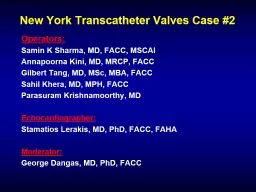

Operators Samin K Sharma MD FACC MSCAI Annapoorna Kini MD MRCP FACC Gilbert Tang MD MSc MBA FACC Sahil Khera MD MPH FACC Parasuram Krishnamoorthy MD Echocardiographer ID: 829951
Download The PPT/PDF document "New York Transcatheter Valves Case #2" is the property of its rightful owner. Permission is granted to download and print the materials on this web site for personal, non-commercial use only, and to display it on your personal computer provided you do not modify the materials and that you retain all copyright notices contained in the materials. By downloading content from our website, you accept the terms of this agreement.
Slide1
New York Transcatheter Valves Case #2
Operators:
Samin
K Sharma, MD, FACC,
MSCAI
Annapoorna
Kini
, MD, MRCP, FACC
Gilbert Tang, MD, MSc, MBA, FACC
Sahil
Khera
, MD, MPH, FACC
Parasuram
Krishnamoorthy
, MD
Echocardiographer
:
Stamatios
Lerakis
, MD, PhD, FACC, FAHA
Moderator:
George Dangas,
MD,
PhD, FACC
Slide2Disclosures
Samin K. Sharma, MD, FACC
Speaker’s Bureau – Boston Scientific Corp, Abbott Vascular Inc, ABIOMED, CSI
Annapoorna S. Kini, MD, FACC Nothing to disclose Gilbert Tang, MD Physician proctor and consultant for Medtronic, consultant for Abbott, W. L. Gore & AssociatesGeorge Dangas, MD Nothing to disclose
Slide3NY Transcatheter Valves Case 2
: JW, 77 y/o M
Presentation:
Worsening dyspnea on exertion, NYHA class III symptoms
PMH:
HTN, HLD, NIDDM, ex-smoker, COPD, BPH, T-cell lymphoma undergoing active chemotherapy
, non obstructive CAD, dilated ascending aorta (4.1cm)
Medications:
ASA, albuterol, atenolol, amlodipine, fluticasone, furosemide, metformin, atorvastatin
Labs (10/23/20):
Hemoglobin 8.9, K 4.2,
Plt
76, Cr 0.79
EKG (11/23/20):
SR with LVH
Cath (07/25/17):
Non obstructive
CAD
TTE
(11/23/2020):
LVEF 64%, severe low flow low gradient aortic stenosis. Bicuspid aortic valve. Stroke volume index of 29.5ml/m2. Peak velocity 3.3m/s, PG 44mmHg, MG 27mmHg, AVA of 0.89cm2. Normal RV function. Mild MR. No pulmonary HTN
Slide4Trans-thoracic echocardiogram
TTE-
Short axis view of heavily calcified bicuspid valve
Slide5Aortic
Annulus-
Large annuliMax: 36.6 mm
Min: 27.4 mm
Mean: 32 mm
Perimeter = 99.9mm
Area = 763.7 mm
2
LVOT
Max: 33.1 mmMin: 25.4 mmMean: 29.3 mmPerimeter = 90.9 mmArea = 631.5 mm2
CTA: Aortic Annulus and LVOT
Annulus and LVOT
Annulus: 27.4x36.6 mm
Area: 763.7 mm2 Perimeter: 99.9 mm
LVOT: 33.1x25.4 mmArea: 631.5 mm2 Perimeter: 90.9 mm
Slide6CTA: SOV, STJ
Sinus of Valsalva
RCC = 39.7 mm
LCC = 38.6 mm
NCC = 41.4 mm
Sinotubular
Junction
Min = 39.9 mm
Max = 41.2
Mean = 40.5
STJ height (above annulus) = 30.8 mm
NCC: 41.4 mm
LCC: 38.6 mm
RCC: 39.7 mmSTJ 39.9x41.2mm
Slide7Coronary heights
LCA = 17.9 mm
RCA = 15.6 mm
Root angle = 43 deg
CTA: Coronary Heights, Root, Hockey puck
Root angle: 43 deg
LCA: 17.9 mm
RCA: 15.6 mm
Slide8Femoral Arterial Access
Longitudinal View RFA and RIA
Access 3D
Longitudinal View LFA and LIA8.6x11.9mm8.3x8.4mm8.4x8.9mm
9.1x10mm
8.6x9 mm
8.9x9.6mm
Slide9Aortic Arch- Bovine
LAO: 39°
Caudal:11°
LAO: 79°
Caudal: 6°
Slide10Presentation:
77
year old male with a bicuspid aortic valve, with low SVI consistent with LFLG severe
AS now with worsening
NYHA Class III CHF symptoms
TTE:
Bicuspid AV with calcified R/L raphe and severe AS
STS risk mortality:
1.865
%
Course:
Patient evaluated by Heart Team and due to multiple co-morbidities including his active cancer and COPD was determined to be extreme risk for surgical AVRPlan: TF TAVR with 29 mm (+2cc) Sapien
3 Valve via right percutaneous approach and possible sentinel device
Summary of Case